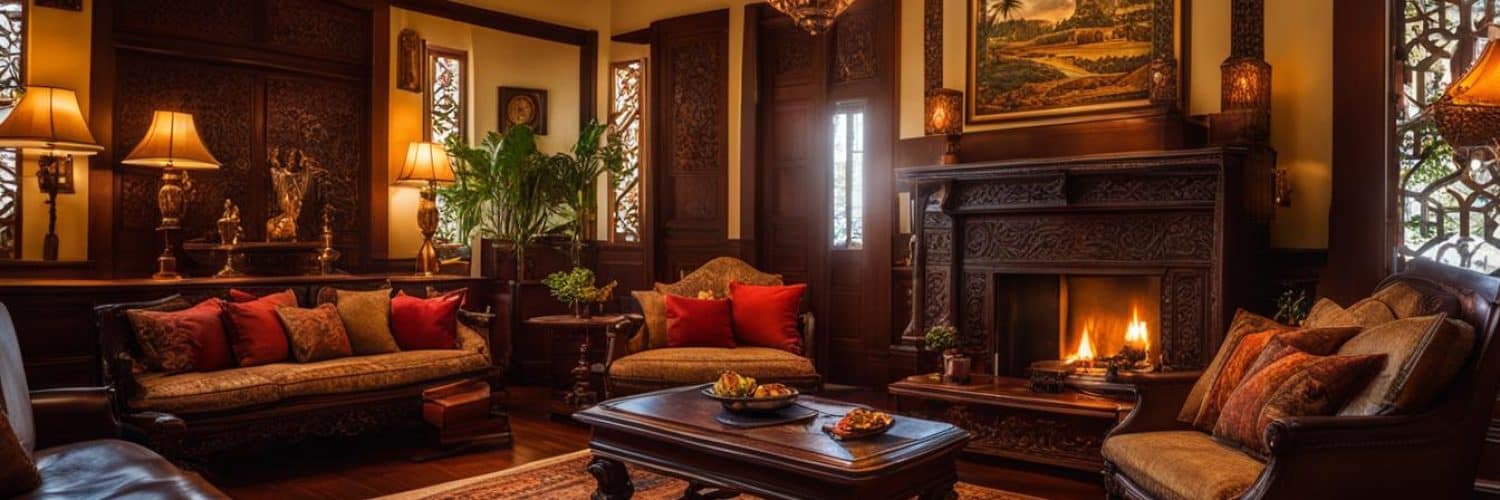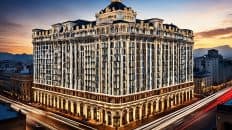As you meander through the vibrant streets of Cebu City, a poignant piece of the past awaits you at the Yap Sandiego Ancestral House. Revered as a treasured historical landmark, this edifice is more than just a mere tourist attraction. It is a living museum echoing the nuanced symphony of Filipino history and cultural heritage. Erected in the 17th century, it is reputed to be among the eldest surviving residential houses in the Philippines. Every corner of this ancestral home exudes the rich aesthetic and cultural panorama of the Spanish colonial period, beckoning travelers to step in and voyage back through centuries of lineage and legacy.
Key Takeaways
- Discover one of the Philippines’ oldest houses and immerse in the storied history of Cebu.
- See the stunning wooden architecture that captures the essence of Filipino life during Spanish colonization.
- Experience the historical ambiance of this ancestral home firsthand and learn about its significance to Cebu’s cultural heritage.
- Explore the intricate interior designs reminiscent of the ancestral Filipino lifestyle infused with Spanish and Portuguese influences.
- Connect with the enduring legacy that the Yap Sandiego Ancestral House continues to hold as a beacon of Filipino culture.
Unveiling the Beauty of Yap Sandiego Ancestral House, Cebu Philippines
Stepping into the Yap Sandiego Ancestral House is like wandering into a piece of Cebu Philippines’ living history, a place where time has stood resolutely still amid the pulsing life of a modern city. As you traverse the threshold of this historical landmark, you’re greeted by a haunting charm that whispers tales of a bygone era. Here, the amalgamation of Chinese, Spanish, and Filipino architecture converges to form not just a structure, but a heritage site rich with cultural resonance.
The ancestral home is defined by its stately wooden presence—a testament to the durability and grace of Filipino craftsmanship. With each corner of the house decked in antique finery and the warm glow of coral stones emanating a comforting warmth, the antiquated abode invites visitors to explore deeper.
The lavish attention to detail is evident in the intricate crochet pieces that drape over furniture surfaces, an homage to the manual dexterity and artistic vision of the Filipino people. The estate’s interior sings with elegance, featuring hardwood floors that reflect the muted glow of sunlight filtering in through capiz shell windows, inviting a dance of light and shadow.
- Elegant Antiques: Each carefully preserved piece within the residence weaves its own narrative, resonating with the soul of Filipino artistry and heritage.
- Warm Ambiance: The marriage of woods, such as molave and narra, with coral stones brings forth an ambiance steeped in authenticity and cultural significance.
- Historical Pride: Maintained with relentless dedication, the ancestral home stands proudly as an emblem of the rich historical tapestry of Cebu Philippines.
- Garden Splendor: Not to be overshadowed, the lush garden area completes the sensory journey with vibrant foliage framed against the rustic charm of the heritage site.
As a cherished relic of the past, the Yap Sandiego Ancestral House remains one of the most vivid embodiments of Filipino architecture and heritage within the heart of Cebu. It’s a place where stories of the past are rooted deeply in the tangible and ethereal allure, calling out to be discovered and remembered once more.
Yap Sandiego Ancestral House, Cebu Philippines: A Portal to the Past
Stepping into the Yap Sandiego Ancestral House is not just about witnessing the epitome of cultural heritage and historical elegance, but also about traversing through the corridors of time. Let’s delve into the depths of its storied past and understand why it remains a culturally significant landmark in Cebu, Philippines today.
The House’s Historical Significance
The Yap Sandiego Ancestral House isn’t merely a structure; it’s a chapter from the history books of the Philippines that materializes before our eyes. Founded by Chinese merchants back in 1675, the house has withstood the test of time, witnessing the life of a prominent Filipino-Chinese family during the era of Spanish colonization. Its existence for centuries makes it one of the nation’s eldest residential establishments, harboring stories within its walls that are crucial to the Philippine narrative.
Architectural Marvel with Chinese, Spanish, and Filipino Influences
The Yap Sandiego Ancestral House is an architectural tapestry woven with Chinese, Spanish, and Filipino threads. Its unique design is reflective of the multicultural influences that shaped the Philippine archipelago over the centuries. The identity of the house is expressed in every coral stone and terracotta tile, telling of a heritage that is distinctly Filipino while highlighting the elegance of its Chinese and Spanish influences.
The Sandiego Legacy and Current Ownership
The legacy of the Sandiego family persists, vividly living through Val Sandiego—heralding from the lineage of the original stewards. Val, the endearing great great-grandson of the owners, fiercely preserves the ancestral abode. Despite lucrative offers tempting a transfer of ownership, his dedication ensures the perpetuation of the house as a historical staple, representing the pride of Cebu, Philippines, and maintaining the honor of his forebears. The commitment to the family’s name is a testament to the deep roots and respect for the historical significance and cultural heritage that the Yap Sandiego Ancestral House upholds.
| Year Established | Original Owners | Architectural Influences |
|---|---|---|
| 1675 | Chinese Merchants | Chinese, Spanish, Filipino |
| House maintained by Val Sandiego, directly descended from original owners | ||
Step Inside the Ancestral Home
As you cross the threshold of the Yap Sandiego Ancestral House, you step back in time to an era where the echoes of Filipino culture are most palpable. This historical landmark, nestled in the very heart of Cebu City, is more than just a tourist attraction; it is a living museum, preserving the intimate sanctity of Filipino heritage.
The ground floor, with its rustic gravel and the gentle creak of aged wooden staircases, offers a narrative steeped in antiquity. Here, shoe covers are graciously provided, ensuring that the original state of the >floor remains preserved for future generations. Among the rooms outfitted with pristine antique furniture, visitors witness the interplay between functional living space and time-honored tradition.
Ascend the weathered steps to the upper level, and you invite your eyes to a feast of history hung upon every wall and corner. The detailed latticework captures one’s imagination, epitomizing the skilled craftsmanship of a bygone era. The view into the verdant garden below adds a splash of tranquility amidst the treasury of antiques within the home’s storied walls.
Venturing into this nearly 350-year-old residence is like opening a storybook where every page is a tangible slice of Cebu’s history.
- The Entryway: Embark on a Historic Encounter
- The Lower Floor: Timeless Elegance and Charm
- The Staircase: A Path to the Past
- The Upper Floor: Latticework and Legacy
- The Garden View: A Glimpse into Secluded Splendor
In every corner, there lies a silent witness to the vibrant past, making a visit to this ancestral home a must for anyone who cherishes the rich tapestry of Filipino culture and longs to connect with the soul of Cebu City.
Understanding Filipino Architecture Through Yap Sandiego Ancestral House
The Yap Sandiego Ancestral House in Cebu Philippines serves as a testament to the timeless allure of Filipino architecture. It is a standing monument capturing the essence of Cebu Philippines’ distinct cultural heritage. Visitors here do not just see a structure; they unravel the narrative of a nation’s architectural evolution.
Fusion of Cultural Aesthetics
Few places better showcase the seamless blend of diverging aesthetics than this iconic ancestral home. Here, the interweaving of Spanish and Chinese influences has formed a unique architectural style, intrinsic to the Filipino cultural identity.
Preservation of Wooden and Coral Stone Structures
Meticulous preservation efforts at the Yap Sandiego Ancestral House ensure that the splendor of ancient Filipino architecture is not lost to time. Its enduring wooden and coral stone structures are a standing tribute to the dedication and respect for Philippine’s historical treasures.
Distinctive Features of the Ancestral Home
Majestic and yet intimately familial, the ancestral home is replete with features that are as distinctive as they are evocative of the Filipino spirit. We see the compatibility of beauty and resilience reflected in the sturdy Molave and Narra woods that make up much of its frame, as well as the delicate artistry of its decor.
| Material/Element | Cultural Influence | Function/Significance |
|---|---|---|
| Coral Stone Walls | Spanish | Basement supports showcasing colonial styles |
| Narra Wood | Filipino | Durable foundation material speaking to Philippine forestry |
| Molave Wood Ceilings and Religious Imagery | Chinese | Ornamental designs signifying the spiritual layer of architecture |
| Red Tisa Clay Roof | Indigenous/Filipino | Traditional roofing that has weathered centuries |
| White Linen | Spanish | Classic colonial bedchamber aesthetic |
By exploring the storied walls and historic corridors of this Cebu Philippines iconic site, one gains not only knowledge but also a profound appreciation for the cultural heritage that Filipino architecture so vividly embodies.
The Stories Told by Antique Collections
The Yap Sandiego Ancestral House, a prominent historical landmark nestled within the heart of Cebu City, harbors an impressive collection of antique furniture that whispers tales of a bygone era. Walking through its doors is akin to stepping into a living narrative, where each meticulously preserved piece reflects the opulence and cultural heritage of its prime.
Passed down through generations, the artifacts serve as silent historians, providing us a glimpse into the lives of the prosperous Filipino-Chinese families during the Spanish colonial period. This cherished museum not only celebrates the past but also honors the resilience of these treasured belongings through centuries of history.
| Item Category | Description | Historical Relevance |
|---|---|---|
| Religious Imagery | Handcrafted statutes and paintings reflecting deep spiritual beliefs. | Symbolizes the integration of Catholicism into local customs. |
| Classic Paintings | Portraits and landscapes adorning the household’s walls. | Depicts the artistry and wealth of Cebu’s colonial residences. |
| Decorative Kitchenware | Intricate china and silverware used for grandiose feasts. | Represents the fusion of Chinese influence on Filipino dining culture. |
| Antique Furnishings | Elegantly carved wooden furniture that has withstood the test of time. | Exudes the craftsmanship and status of former inhabitants. |
Each visit to the Yap Sandiego Ancestral House offers an indelible journey through time, with the antique furniture and collections providing a tangible connection to Cebu City’s rich cultural heritage.
Immersive Experiences in Cebu City’s Historical Landmark
Delve into the rich tapestry of Cebu’s past with a visit to the illustrious Yap Sandiego Ancestral House. This treasured tourist attraction extends beyond mere sightseeing, offering an array of immersive experiences that celebrate Cebu City’s vibrant cultural heritage. Guests are invited to partake in guided tours that unravel the storied history behind the centuries-old walls of this cherished landmark.
Guided Tours full of Anecdotes
Immerse yourself in the enduring legacy of the Yap Sandiego Ancestral House through engaging guided tours. Each tour is a journey narrated with passion and enriched with anecdotes, allowing visitors to walk in the footsteps of the Filipino-Chinese merchants who once called this place home. Knowledgeable caretakers provide captivating orientations in the various areas of the house, ensuring that every visitor leaves with a deeper understanding and appreciation for Cebu’s historical elegance.
The Charm of the House’s Garden
Step outside and be enchanted by the lush tranquility of the house’s garden. A pristine oasis within the bustling metropolis of Cebu City, the garden showcases a historic wishing well and a repurposed wooden boat adorned with an array of vibrant plants. The serene ambience of this outdoor space offers a charming backdrop for reflection and admiration of the house’s architectural wonder.
The Cultural Relics on Display
As part of the unique experiences, guests encounter cultural relics that underscore the Philippines’ rich heritage. The house proudly exhibits sacred images of Santo Niño and the Virgin Mary, as well as maritime artifacts like a wooden boat that traversed the waters to Mactan Island. These displays allow visitors to stand in close contact with the tangible symbols of devotion and exploration that are integral to the Philippine cultural narrative.
A Stroll Through the Yap Sandiego Ancestral House Museum
Immerse yourself in the intricate blend of Cebu’s history and culture as you wander the storied halls of the Yap Sandiego Ancestral House Museum. Located in the heart of Cebu Philippines, this heritage site stands as a testament to the island’s rich past, offering visitors a unique perspective on the ancestral home that has seen centuries unfold.
Up-close with Ceramics, Porcelain, and Religious Icons
The museum showcases an extensive collection of artifacts that reflect the spirituality and daily life of the Filipino people during Spanish colonization. Each piece, curated over generations, from exquisite Ming Dynasty ceramics to intricate Spanish porcelain, holds a story waiting to be discovered.
Bedchambers of the Past: A Peek into the Master Bedroom
Step into the tranquility of the master bedroom, a sanctuary meticulously preserved to give an authentic glimpse into the lifestyle of Cebu’s historical elite. The grand antique four-poster bed set against a backdrop of soft ambient lighting invites a moment of quiet reverence for the lives that once filled these rooms.
Artifacts that Narrate Centuries of History
From the robust religious figures that stand guard over the home to the delicate porcelain that adorns the shelves, every artifact within the Yap Sandiego Ancestral House Museum contributes to the rich tapestry of Cebu’s history. These treasures, relics of an era gone by, continue to narrate the resonance of a heritage site deeply interwoven with the identity of Cebu Philippines.
The museum not only preserves the tangible elements of history but also the intangible spirit of Cebu, encapsulated within its walls. Visitors leave not just with photographs, but with memories of an ancestral home that is a pivotal narrative in the history of Cebu.
Location and Accessibility of the Heritage Site
Visiting the Yap Sandiego Ancestral House is a journey through history, situated in the heart of Cebu City. This treasured heritage site is easily reachable, providing a memorable cultural experience for those who walk its aged corridors.
Directions to Mabini Street, Cebu City
Whether you’re a seasoned traveler or a curious local, finding your way to the Yap Sandiego Ancestral House is straightforward. Nestled on Mabini Street, it lies in the vicinity of well-known landmarks such as the Heritage of Cebu Monument and the bustling Colon Street. Conveniently accessible by foot, taxi, or jeepney, this historical gem is a must-visit destination on your Cebu City itinerary.
Entrance Fees and Operating Hours
To accommodate your schedule, the Yap Sandiego Ancestral House welcomes visitors every day from 9 am to 7 pm. The entrance fee is kept minimal, echoing the site’s commitment to preserving the beauty and significance of Cebu’s cultural heritage. Your contribution not only grants access to the timeless stories of the ancestral home but also supports ongoing preservation so future generations may continue to appreciate its historical grandeur.
Preparation Tips for Your Visit to the Tourist Attraction
Embarking on a historical journey through the Yap Sandiego Ancestral House in Cebu City can be a profound experience that connects you with the rich cultural heritage of the Philippines. To fully appreciate the beauty and significance of this cherished tourist attraction, a bit of preparation can go a long way. Comfort is key when navigating the historic grounds; so, opt for sensible footwear suitable for traversing gravel paths and ancient wooden floors. Additionally, while stepping back in time, remember to protect the past by preparing to use shoe covers before climbing the venerable staircase.
Photography enthusiasts will be delighted to know that capturing memories of this enchanting site is encouraged. Be mindful, though, to treat every artifact and corner of the house with respect, preserving the integrity of the treasured items and spaces for future generations to enjoy. In your journey through the home and garden, it’s recommended to set aside ample time. Doing so allows you to immerse yourself in the compelling narratives and subtle details that epitomize the home’s historical and cultural narratives.
Before you set out, consider these practical travel tips, which will prepare you not just for a visit, but for an experience. The Yap Sandiego Ancestral House awaits, ready to reveal its stories and wonders to those eager to listen and learn. With thoughtful preparation, your visit will not only be enjoyable but also meaningful, as you walk away with a newfound appreciation for the cultural gems nestled in the heart of Cebu City.
FAQ
What is the historical significance of the Yap Sandiego Ancestral House?
The Yap Sandiego Ancestral House, constructed in the late 17th century, is one of the oldest residential homes in the Philippines and serves as a historical landmark in Cebu City. It provides an authentic look into Filipino life during the Spanish colonial era and is a standing reminder of the country’s rich cultural heritage.
Where is the Yap Sandiego Ancestral House located?
The Yap Sandiego Ancestral House is located on Mabini Street in Cebu City, Philippines. It’s easily accessible and within walking distance from other historical attractions like the Heritage of Cebu Monument and the historic Colon Street.
What architectural styles are reflected in the Yap Sandiego Ancestral House?
The architecture of the Yap Sandiego Ancestral House reflects a blend of Spanish, Chinese, and Filipino influences. It features wooden ceilings, coral stone walls, and antique furniture, indicative of the era’s cultural aesthetics.
Who currently owns the Yap Sandiego Ancestral House?
The Yap Sandiego Ancestral House is owned by Val Sandiego, the great great-grandson of the original owners. He has preserved the ancestral home for generations and continues to maintain its historical and cultural significance.
Can visitors take a tour of the Yap Sandiego Ancestral House?
What are some distinctive features of the Yap Sandiego Ancestral House?
Distinctive features of the house include the hard Molave wood structure, red Tisa clay roofing, intricate latticework, and the refined wooden banisters of the narra staircase. These elements collectively highlight the house’s ancestral history and the dedication to its preservation.
What type of antique collections can be seen in the house?
The Yap Sandiego Ancestral House showcases a vast collection of artifacts, including antique furniture, religious images, classic paintings, and decorative kitchenware. These items offer insights into the opulent lifestyle of Filipino-Chinese residents during the Spanish colonial period.
What are the operating hours and the entrance fees for the Yap Sandiego Ancestral House?
The ancestral house operates daily from 9 am to 7 pm and requires a minimal entrance fee, which goes towards the preservation and maintenance of this cultural heritage site.
Is photography allowed inside the Yap Sandiego Ancestral House?
Photography is allowed within the Yap Sandiego Ancestral House. Visitors are encouraged to capture their experience but are reminded to handle all objects with care and respect the house’s historical integrity.
What preparations should be made before visiting the Yap Sandiego Ancestral House?
Visitors should wear comfortable shoes, as there are gravel and wooden surfaces to walk on. It is also suggested to cover footwear upon ascending the historic staircase. Allocating enough time to fully enjoy the house and garden is recommended for a complete historical and cultural experience.











Add comment